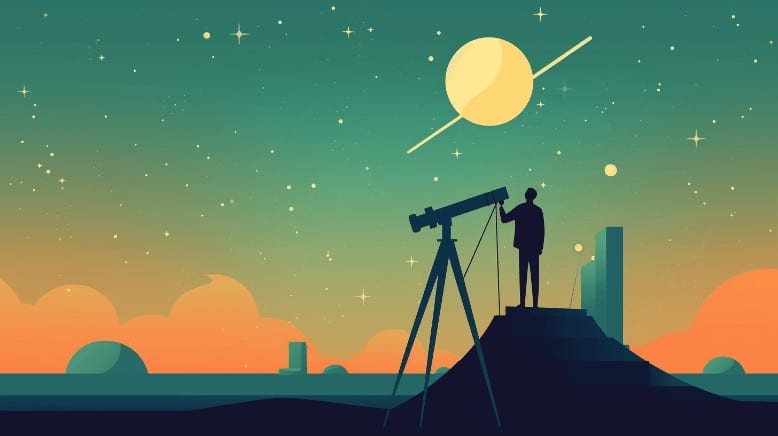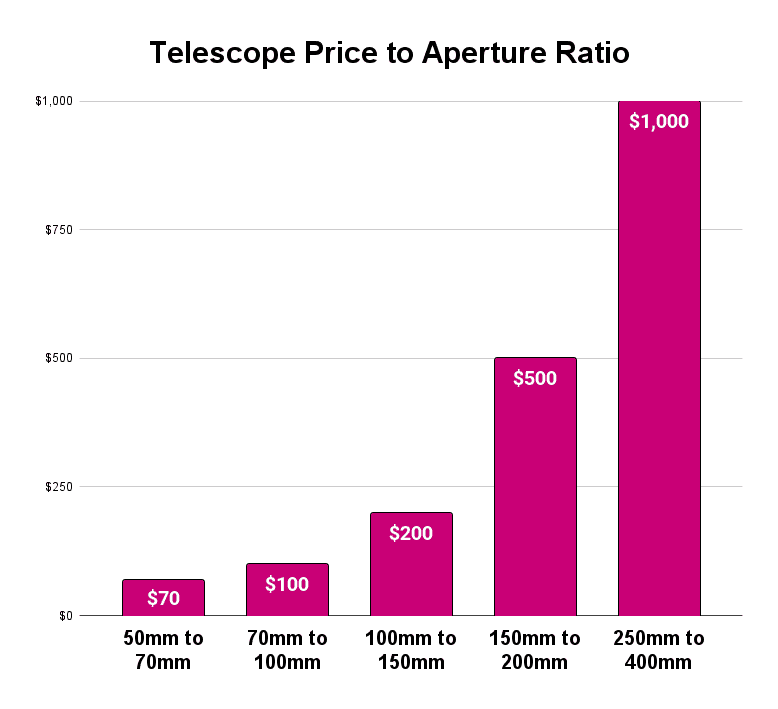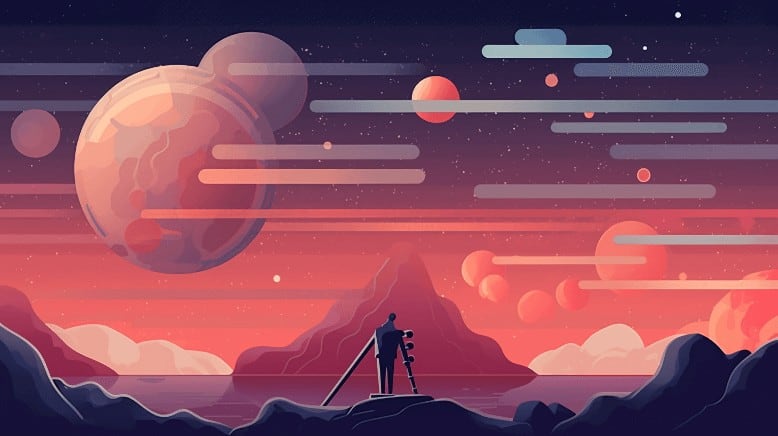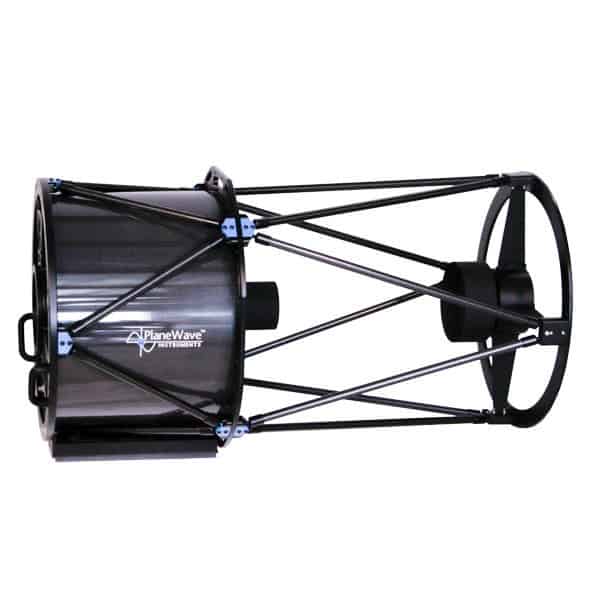Buying a telescope can be a bit of a minefield. Prices vary hugely and it can be hard to understand what you are getting for the money.
In this article we answer the question, how much does a good telescope cost?
We want to clarify the minimum you would need to spend, and what you get if pay for a more expensive telescope.
See the summary below or read on for further detail and examples of good and bad telescopes to buy for different budgets.
TLDR – How Much Does a Good Telescope Cost
- $70-$100 is the minimum you need to spend to get a good beginner’s telescope
- Go for a trusted brand of telescope manufacturer like Celestron, Sky-Watcher, Orion, Explore Scientific, or any other that would be sold by a reputable astronomy equipment store rather than just Amazon
- You generally get what you pay for, so if you can spend more you will be rewarded with a better telescope that will give you better views. The key to this is the aperture – the higher this is the better

How Much Does a Telescope Cost?
Our list below provides an at-a-glance guide to how much you need to spend on a telescope and what you will get for your money:
- Up to $70: Don’t bother. Pretty much anything below $70 will not be good enough.
- $70-$100: Budget refractor and Dobsonian reflector telescopes with 50mm to 70mm aperture that can be good for beginners.
- $100-$200: More powerful Dobsonians and refractors with 70mm to 100mm aperture.
- $200-$500: Intermediate reflector and refractor telescopes with 100mm to 150mm aperture.
- $500-$1000: Budget computerized catadioptric telescopes or large (200mm/8-inch aperture) manual Dobsonians.
- $1000-$4000: Mid-range to advanced computerized telescopes with 200mm/8-inch aperture.
- $3000-$4000: Smart telescopes with in-built cameras – fully automated and smartphone operated.
- $4000-$20,000: The most powerful telescopes you can buy to use at home – 10-inch to 16-inch aperture with good computerized mounts.
- $20,000-$600,000: Advanced telescopes for observatories.
Obviously, these are broad categorizations so let’s look at each of these levels in more detail.

Telescopes for up to $70
In our opinion, you need to spend at least $70 to get a decent telescope so avoid anything below this.
You may see models online or in department stores boasting “100x magnification” or something similar, but these are best avoided.
They will have such small aperture and low-quality optics that the views will be poor.
Telescopes for $70-$100
$70-$100 is the bare minimum to spend on a telescope to get something that is actually usable.
In this price bracket, you can get a budget refractor or Dobsonian reflector telescope with 50mm to 76mm aperture (like the Celestron FirstScope pictured above).
With these you should get good views of the moon and maybe the planets of our solar system if the conditions are right. Don’t expect too much though.
Telescopes in this price range are good for casual use, for taking on trips, or as a first telescope for a child to get them to just start to learn their way around it without worrying too much if it breaks.
See the Best telescopes for Kids and the Best Travel Telescopes for recommendations on specific models.
Telescopes for $100-$200
For $100-$200 you can get more powerful tabletop Dobsonians or refractor telescopes with 76mm to 100mm aperture. The Celestron 80mm Travel Scope pictured above is a good example.
This is a better price to aim for if you can as you are opening up to much more capable telescopes that will provide better viewing opportunities.
Beginners and families who want something more powerful should be able to get a model that’s right for them by spending this much.
See the Best Telescopes for Beginners for more options.
Telescopes for $200-$500
In this price bracket, you can get yourself intermediate reflector and refractor telescopes with larger 100mm to 150mm aperture.
These are more serious telescopes that provide high-quality views of the night sky.
You can also find some budget computerized options, like the Sky-Watcher Virtuoso GTI 130P pictured above.
See the Best Intermediate Telescopes for recommended models.
Telescopes for $500-$1000
Once you go over $500 you can consider two options:
- Large (150 to 200mm/6 to 8-inch aperture) manual Dobsonians, or
- Budget computerized catadioptric telescopes.
The 6 to 8-inch Dobsonians are fantastic value and with these, you will really not be limited at all in what you see. The downside is that they are fairly large and heavy. The Sky-Watcher 8-inch Dobsonian pictured above is an example of this.
You can watch Astronomy YouTuber Ed Ting rave about 8-inch Dobsonians in this video:
The other option is to go into the realm of computerized (GoTo) telescopes. These scan the sky and locate objects for you, and so make stargazing much quicker and easier.
For this price range, you can get a good, small catadioptric (compound) telescope on a GOTO mount.
This is great for beginners if you have the budget – see the Best Computerized Telescopes.
You can also now get some budget smart telescopes in this range, like the ZWO Seestar S50 or Dwarflab Dwarf II.
Telescopes for $1000-$4000
Once you go over $1000 you can consider a number of mid-range to advanced computerized telescopes with around 200mm (8-inch) aperture.
These will provide a combination of great viewing opportunities with the convenience of a computerized mount.
See Celestron 8-inch Telescopes for some great options like the Nexstar Evolution 8 pictured above.
Telescopes for $3000-$4000
A slightly separate category, but worth considering if you have the money is a smart telescope like Unistellar eVscope 2.
These are ultra-modern, fully-automated telescopes that you control with your smartphone.
They can not only locate objects for you but also photograph them with built-in cameras and send the pictures straight to your phone for easy sharing.
To understand more, see the Best Smart Telescopes.
Telescopes for $4000-$20,000
If you have a budget like this then you can consider the most powerful telescopes you can buy to use at home.
These are 10-inch to 16-inch aperture telescopes with the best computerized mounts.
See our overview of this: The Most Powerful Telescopes You Can Buy.
Telescopes for $20,000-$600,000
For serious astronomers with their own observatories, you can spend anything from $20k to $600k.
These are specialist bits of gear that require specialized installation.

What Factors Influence Telescope Price?
Understanding all the telescope specifications listed can be difficult.
In this section, we detail what factors influence telescope price, but the key things to look at are:
- Aperture – This is the key measurement of a telescope’s power. The higher this is the better, but the more expensive it will be.
- Mount – Whether the telescope comes with a manual or computerized mount. Computerized is better (for most), but is more expensive.
Read below for a more detailed overview of this and other factors to consider that impact telescope price:
Aperture
Aperture is the key measurement of a telescope’s power. It is the measurement of the diameter of the telescope lens in either millimeters or inches.
The higher aperture is, the brighter and clearer the views will be, and so the better the sights that you are rewarded with.
The downside is that the higher the aperture, the more expensive it will be.
The price-to-aperture ratio also increases exponentially as you can see illustrated in this chart (note, these are rough estimates that will vary greatly):

(If you want to understand more about this, see our article Why Are Telescopes So Expensive?).
50mm to 70mm is the bare minimum aperture you’d want for looking at the moon and maybe some planets when the conditions are right.
70mm to 100mm is a substantial improvement and so go for this if you can. As this gets higher, the telescope’s capacity only gets better.
If you can afford a model with 150mm to 200mm (6-inch to 8-inch) then you will have fantastic capacity for seeing even far-off deep-sky objects like other galaxies (when the conditions are right).
Type
There are three main types of telescope:
- Refractors
- Reflectors
- Catadioptrics
Essentially, refractors are built with lenses, reflectors with mirrors, and catadioptrics with a combination of both.
The main practical things that you need to know are though:
- Refractors are the classic telescope type and the simplest to use. They get expensive with higher aperture though.
- Reflectors provide the best value for money but are large and bulky and so not great for everyone.
- Catadioptrics are smaller and more compact, but more expensive in comparison to a reflector with the same aperture.
Read Reflector vs Refractor Telescopes to understand more.
Brand
There are a few very good telescope manufacturers that can be relied upon if you are getting one of their models. These are:
You pretty much get what you pay for if you stick to one of these brands.
There are other good brands too, like Explore Scientific, Zhumell, and iOptron, as well as others at the more-specialized high-end.
Read What are the Best Telescope Brands? to understand more.
Mount
As noted at the start, a key that will influence price is whether the telescope comes with a manual or computerized/GOTO mount:
- With manual mounts, you need to locate what you want to look at in the night sky and point your telescope in the right direction.
- With computerized mounts, this is done for you – they scan the sky, tell you what’s available to see and you select an object (e.g. Mars or the Andromeda galaxy) and it finds it for you.
Computerized mounts are much quicker and easier, but more expensive and require a power source.
The other thing is that mounts are generally either Alt-Azimuth or Equatorial. In short:
- Alt-Az mounts are good for astronomy
- Equatorial are good for astrophotography
See Altazimuth vs Equatorial Mounts for more on this.
See also our guides to all different types of telescope mounts and the Best Telescope Mounts for Astrophotography.
Shipping cost
Depending on where you are in the world and where you buy from, the shipping cost is a factor because telescopes are generally pretty heavy, bulky, and (to some degree) fragile. Therefore you want them shipped with care from a reliable retailer.
A further factor to consider is the cost to return the telescope if you decide it is not right for you.
This may be free from some retailers, but if you have bought from overseas it may be considerable and so is worth looking at before buying.
Accessories
Most retail telescope packages will come with a number of things:
There may also be things like barlow lenses, finderscopes, and carry cases.
If not, you may need to buy them separately and so that should be considered as part of your budget.

FAQs: How Much Does a Telescope Cost?
How much does a good telescope for astrophotography cost?
Most of the information in this article is relevant to telescopes for observational astronomy use – i.e. looking at objects in the night sky. This is as opposed to using telescopes for photographing objects in the night sky.
You can use most telescopes for astrophotography, the easiest way with most telescopes is to get a smartphone adapter and just use your phone.
If your telescope and mount are big enough you could instead attach a DSLR or mirrorless camera for better results.
However, there are telescopes that specialize in astrophotography for the best results in deep-sky imaging. These tend to be more expensive.
See the Best Telescopes for Astrophotography to read more.
Where is the best place to buy a telescope?
If you are buying new, then you can consider:
- Amazon – No introduction needed. A good range of telescopes with good delivery service and favorable return policies.
- Agena Astro – Highly recommended astronomy retailer in the US. Will give good, honest advice to help you get what is right for you.
- High Point Scientific – as above
- Optics Planet – US retailer of outdoor gear with a good telescope range
- Astroshop – European astronomy retailer. Often has gear that is hard to find in the US and will ship there.
- Orion – In a great move a long time ago, Orion bought the domain telescope.com and this is where you can buy Orion and Meade Instruments models directly
You can also consider finding used models from places like eBay, Craigslist, and Facebook Marketplace.
Are there any cheaper alternatives to telescopes?
If you think that telescopes are too expensive, or are just not right for you for some other reason (e.g. too big), then there are some other options to consider:
- Astronomy Binoculars – Binoculars for astronomy are great because they are not only cheaper than telescopes, they are also easier to use and can just be picked up and carried outside.
- Spotting Scopes – Spotting scopes are compact telescopes generally optimized for terrestrial purposes like bird watching, etc. However, there are some great models for astronomy.
- Monoculars – Monoculars are small, handheld telescopes that are perfect for hiking. There are some good models for astronomy that make for good cheap options instead of telescopes.

Conclusion: How Much Does a Good Telescope Cost?
In summary:
- For a cheap telescope from a good brand, you need to spend at least $70 to $100.
- Spending more than this will get you a telescope that can see much more. Price is generally determined by the aperture – the higher this is the better, but also the more expensive.
- Beyond aperture, whether or not you have a computerized mount will be the other major factor in determining the price.
You could spend, for example, $400 to $500 on a large aperture manual reflector/dobsonian telescope that will be able to see amazing things, but it will be bulky and harder to use.
For the same price, you could get a compact GOTO catadioptric that will be easier to use but will be more limited in what you can see through it.
If you can afford it, a large aperture catadioptric with a computerized mount is perfect for most people but the cost will be pushing $1000.
We hope you found this useful. Telescope prices (and availability) fluctuate a lot, so shop around and, if you can, be patient once you know what you want.











